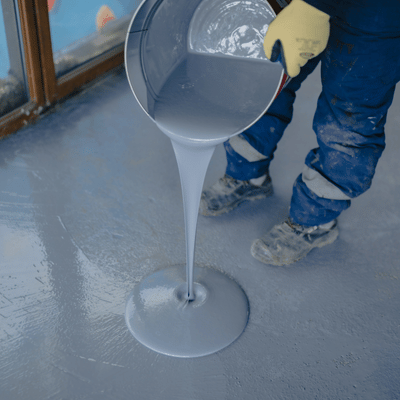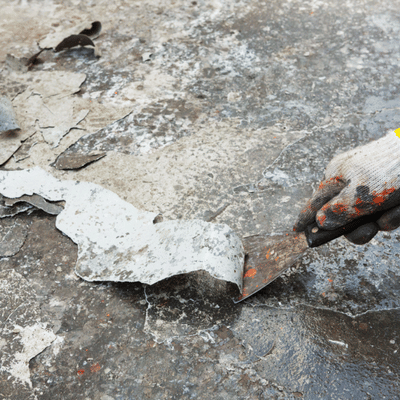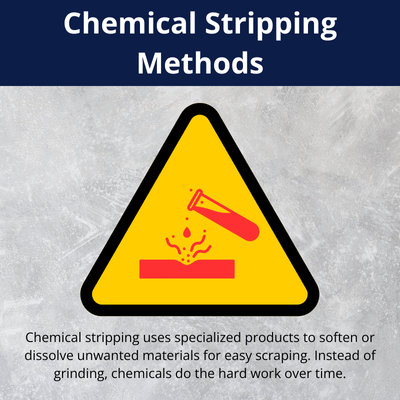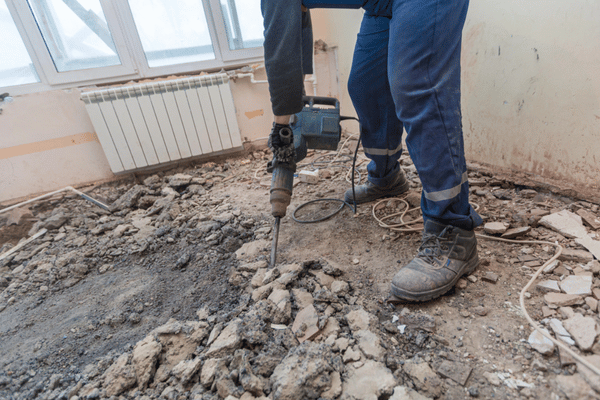Removing old coatings from a concrete floor can feel overwhelming. Whether you're fixing up a garage or restoring warehouse spaces, you'll face this choice: mechanical methods like shot blasting or diamond grinding, or chemical approaches such as using a floor stripper concentrate. Each of these paint removal strategies has its own challenges, from equipment needs to cleanup.
This guide breaks down both methods in simple terms. You'll learn which approach works best for your project, whether shot blasting for heavy coatings, diamond grinding for smoother finishes, or a floor stripper concentrate where chemical compatibility and drying times matter most. Plus, you’ll get updated safety tips for 2025.

Over time, even tough concrete surfaces lose their shine. Finishes get dull, coatings chip, and old floor coverings leave stubborn adhesives behind, which often need paint removal strategies like shot blasting or using a floor stripper concentrate.
Stripping means removing all the old stuff - paint, epoxy, sealers, or glue - to reveal clean concrete ready for a fresh start. This step is vital for any concrete restoration technique or resurfacing strategy, and compatibility between your method and surface is key, whether that’s diamond grinding, chemical solutions, or shot blasting.
Skip proper stripping and your new coating will fail fast. Every successful refinishing project needs a bare, clean surface to start with.
Did you know? Even durable concrete can look new again after stripping. By grinding off wear or peeling away old sealant, you make room for a fresh look and better durability.
Mechanical stripping uses physical force and equipment to scrape coatings off concrete. Here are the main methods:
Diamond grinding uses floor polishers with diamond-embedded pads to wear away the top layer. This is the most popular mechanical method for concrete floor stripping.
Diamond grinding cuts off coatings cleanly while smoothing the surface. Contractors love this method as preparation for polished floors or thin new coatings. Modern equipment combines removal and honing in one step.
This method won't crack your concrete since it doesn't pound the surface. But it can be slow on large areas. You must vacuum all grinding dust before applying new coatings - leftover particles block proper bonding.
Shot blasting fires tiny steel balls at the floor to strip coatings and texture the concrete. This aggressive method can prep thousands of square feet daily.
Shot blasting cleans and textures in one pass - perfect for thick coating removal or epoxy preparation. It creates a higher surface profile than grinding, giving new coatings more "tooth" to grab onto.
The machines recycle steel shot, making the process nearly dust-free with proper vacuum systems. But shot blasting leaves the floor quite rough with dimpled textures that show through thin finishes.
Stay alert when operating - lingering too long in one spot creates craters in concrete. This method works best for heavy-duty jobs like removing old paint in warehouse spaces or prepping for thick overlays.
Scarifying uses machines with spinning drums of tungsten cutters that grind and chip the surface. These machines deliver hundreds of small chisel impacts per minute.
This method sits between grinding and shot blasting for power. Scarifying excels at removing tough adhesives, thick coatings, or textured non-slip finishes. It creates a coarse profile suitable for thick coating application.
Think of scarifiers for stripping old line markings or chunky glue when you don't need a smooth finish. This method works well with floor marking strategies that need complete removal.

Scrapers range from handheld tools to large ride-on machines that physically peel off materials. They excel at removing tile adhesive, carpet glue, or flaking paint.
Contractors often combine scrapers with other methods. For example, scrapers remove bulk adhesive, then grinding cleans up the remnants. After chemical stripping, long-handled scrapers lift the softened coating sludge.
Pros of Mechanical Stripping: Fast and scalable for large areas. Creates surface texture for excellent coating adhesion. No chemical residue to interfere with new applications. Diamond grinding gives uniform, smooth results perfect for thin coatings.
Cons of Mechanical Stripping: Requires heavy equipment most DIYers don't own. Can be noisy and needs industrial power. Wrong technique damages concrete. Completely removes existing surface treatments like integral color or acid stains. Safety precautions are essential for dust control and equipment operation.

Chemical stripping uses specialized products to soften or dissolve unwanted materials for easy scraping. Instead of grinding, chemicals do the hard work over time.
Chemical stripping is the most common method for removing sealers before refinishing concrete surfaces.
Solvent-Based Strippers: Use powerful solvents to break coating bonds. They work fast on tough, multi-layer systems. Traditional strippers contained methylene chloride, but the EPA banned consumer use due to health risks. Modern versions use safer chemicals like NMP or dibasic esters.
Caustic Strippers: High pH chemicals that turn certain paints into soap through chemical reaction. These water-based products work best on old oil-based or acrylic sealers. You must neutralize the floor afterward to prevent coating failures.
Biochemical Strippers: The newest options use organic compounds from soybeans, citrus, or pine. These eco-friendly strippers are much safer but often slower. They come in thick gels that cling to surfaces and don't dry out quickly.
Floor stripper concentrate products often dilute with water - one gallon might make nine gallons of stripping solution.
Start with safety gear - chemical-resistant gloves, safety glasses, and good ventilation. Some products need respirators for organic vapors.
Apply the stripping solution generously across the surface. Spread evenly and let it soak. Drying time ranges from minutes for strong solvents to hours for gentle bio-strippers.
You'll see coatings bubble, wrinkle, or soften as the stripper works. Use scrapers or stiff brushes to remove loosened sludge. Tough systems may need repeat applications.
After scraping, wash the concrete thoroughly. Any leftover residue causes new coating failures. Collect all waste for proper disposal at hazardous waste facilities.
Allow complete drying before applying new finishes. Trapped moisture under coatings leads to early failure.
Pros of Chemical Stripping: Gentler on concrete, preserving original texture. Easier for DIYers on small areas. Works well on detailed areas or vertical surfaces. No dust issues. Modern products offer low-odor, non-toxic options.
Cons of Chemical Stripping: Can be slower and labor-intensive. Multiple applications may be needed for thick coatings. Requires careful waste disposal. Still needs protective gear and ventilation. Some high-performance coatings resist chemical removal.
Your choice depends on several key factors:
Type of Material: Thin sealers respond well to chemical removal. Multiple paint layers need mechanical grinding or scarifying. Thick glue might need combination approaches.
Surface Profile Needed: High-build epoxy coatings need rough profiles from shot blasting or scarifying. Thin sealers work best with smooth surfaces from diamond grinding or chemical stripping.
Project Size: Large areas favor mechanical methods for efficiency. Small projects work fine with chemical stripping and scrapers.
DIY vs Professional: Homeowners can handle chemical stripping with care. Mechanical methods often require professional equipment and expertise.
Many pros use combination approaches - grinding main areas, chemical stripping in corners, and scrapers for edges.

Both methods demand respect for safety. Wear protective gear including safety glasses, chemical-resistant gloves, and respirators when needed. Ensure proper ventilation and dust control.
Read all safety data sheet information before starting. Handle waste properly - chemical sludge goes to hazardous waste facilities, never down drains.
Cost varies by method and project size. Chemical stripping uses less equipment but may need multiple applications. Mechanical methods require expensive machinery but work faster on large areas.
Consider hiring a concrete paint stripping contractor or marking removal service for complex projects. They have proper equipment, training, and handle cleanup requirements safely.
Proper concrete floor stripping sets the foundation for beautiful, long-lasting results. Whether you choose mechanical power or chemical precision, thorough preparation ensures your new coating bonds properly and performs for years.
Don't let old, worn surfaces hold back your space's potential. Contact us today for a free consultation on your concrete floor stripping project. They'll assess your specific needs and recommend the best striping removal process for outstanding results.
Your concrete deserves a fresh start - make it happen with the right stripping approach for your unique situation.

